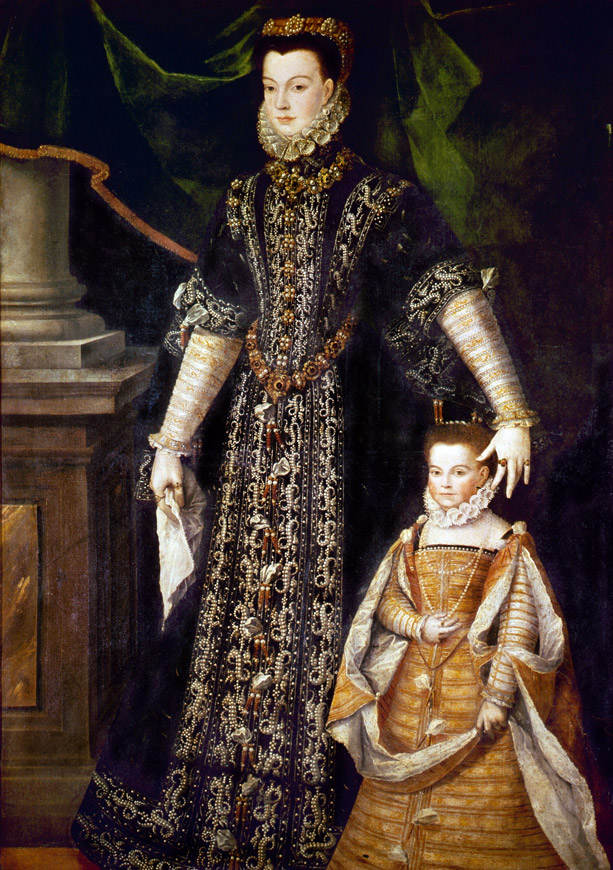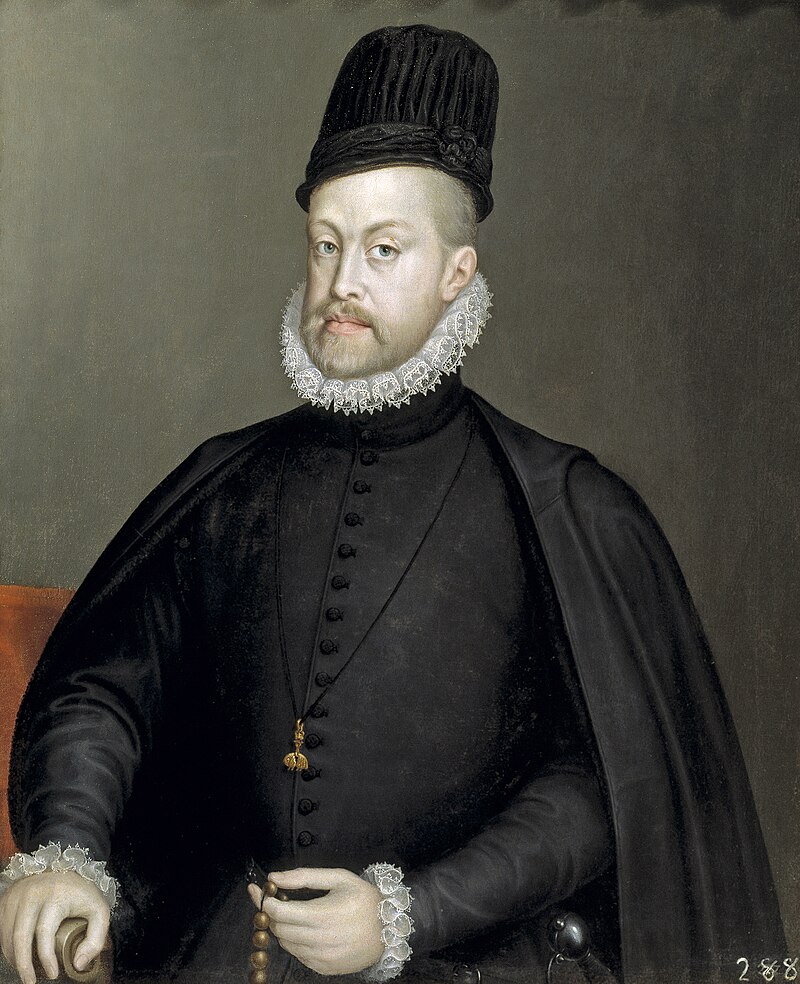Elisabeth Valois and her eldest daughter, Isabel Clara Eugenia, by Juan Pantoja de la Cruz.
On December 7, 1573, Spain found itself waking up to a country in mourning. Flags were lowered, black cloths covered every available space, and the usual celebrations prepared for the birth of a new royal baby were hastily canceled. Confusion arose as a tragic silence covered the palace of Madrid, where King Philip II made his capital. The news came before noon: Queen Elisabeth of Valois died during the night after spending the last twenty hours in labor, giving birth to a girl before dying an hour later due to hemorrhage. The child, it was revealed amongst gossip, had been in the breech position and Queen Elisabeth begged for the survival of her daughter before losing consciousness.
After producing Philip’s heir, Infante Carlos Fernando, Elisabeth Valois gave birth to another son on the birthday of her deceased father-in-law, Emperor Charles V, named Felipe after the king. As such, with two older sisters and two older brothers, little pressure and fanfare had been put on this child, whom Philip described, in a letter to his brother-in-law Maximilian as being “a product of our joy, not our duty.”
Although the new infanta had lived, her baptism was much simpler and somber than that of her older siblings. She was called María Leonor, after the king’s beloved aunts, since her oldest sister was already named Isabel. She was given to the care of wet-nurses, servants, rockers, and a governess, the same shared by her sisters, although she was separated from her other siblings whose grief for their mother was so intense that it caused concerns for Leonor’s health.
Despite the joy brought from her conception, there was little cause for happiness in María Leonor’s life. Her father shut himself away for nearly a month, not allowing anyone to tend to his person, and her siblings were not old enough to be of assistance to the baby infanta. Because of this, the first four weeks of her life were described as ‘the saddest weeks in Spanish history.’ Philip didn’t allow any celebration of the sort during the mourning of his favorite wife. As such, weddings were postponed, and any children born had their own baptisms in silence and without fanfare.
Elisabeth lived for twenty-eight years. She was the daughter of a king, sister of three kings, wife to a king, and mother of a king. Despite all this, Elisabeth’s place in the history books came not from her relation to the men around her, but to her relationship with Catalina Micaela, called Catherine Michelle in English, whose entire life in the British isles had been paved by the mother she lost at age six.
Philip was hesitant to promise their daughter to the heir of the Scottish throne, thinking the poor nation was not worthy of a Spanish infanta, but, according to Philip’s letters to both Mary Stuart and his Catalina herself when she left for Scotland, Elisabeth encouraged the match so ardently that he was unable to refuse. Elisabeth of Valois and Mary Stuart grew up together at the court of Elisabeth’s father and were in-laws for the few months Mary was married to Elisabeth’s older brother, Francis II of France. Because of this, Elisabeth was very inclined towards marrying one of her daughters to Mary’s son, but more importantly, and what may have finally convinced Philip to accept the proposal, was that James Stuart remained the only remaining Roman Catholic who was male and had a legitimate claim to the English throne. Since his marriage to Mary Tudor, Philip II dreamed about bringing England back to the ‘true church’, even proposing marriage to Elizabeth I and the idea of a grandson sitting on that throne was attractive enough for Philip. In a way, every major decision that involved Catherine Michelle Habsburg in Scotland and England could be traced back to Elisabeth.
But at the time, no one in the Spanish court knew the effect Elisabeth would have on history. Philip emerged from his grief on January 1, allowing the celebrations for the New Year to begin, and finally met his infant daughter. Upon holding her for the first, he is rumored to have said: Poor child. You will never meet your mama, but know that she loved you very much. I will tell you many stories about her.
Philip II of Spain by Sofonisba Anguissola. After Elisabeth's death, he wore black for the rest of his life in mourning.
The subject of the king remarrying took at least four months to appear. At the time, Philip had five healthy children, two sons and three daughters, and may have thought that, like his father, he could spend his remaining days as a widower. His councilors, however, thought otherwise. Some of them thought the children needed a high-ranking woman to care for them as a mother since nurses and governesses could only do so much, while others thought a young and lively wife would serve to bring the king out of his still-remaining grief over Elisabeth. Others thought Philip needed more than five children to ensure the continuation and stability of his monarchy. Regardless of the reasons, the few courtiers who broached the subject with Philip were quickly denied, as he was loath to betray his wife’s memory. Although the two infantes were healthy, a child’s survivor was never certain, especially amongst the inbreeding between the Habsburgs, and it would take another tragedy for Philip to realize that.
Carlos Fernando suddenly died on July 13, 1574, of intestinal problems. He had lived for five years, was made Prince of Asturias at the age of two, and would have inherited all of his father’s dominions if he outlived him. Letters show that King Philip was extremely proud of his son, and worked hard to ensure that Carlos wouldn’t follow his elder half-brother’s steps. Don Carlos’ descent into madness was well-remembered and Philip had taken to blaming the instability and warring factions of his courts for his son’s disobedience. As such, he took great steps to ensure that his second son grew under extreme care from his nurses and in a stable home, made possible by his happy marriage with Elisabeth of Valois. At age five, Carlos knew the alphabet and how to dance and, in a letter dated 1573 the king wrote to the Indian Viceroy Pedro de Mascarenhas requesting that he bring an elephant to the Prince of Asturias as a gift from the King of Portugal.
Philip, who had truly loved his children, was heartbroken with Carlos Fernando’s death, who was the child that most resembled Elisabeth in appearance. The new heir, Philip, was put under quarantine to ensure he wouldn't catch his brother’s disease and continuous prayers were said at the Church of Our Blessed Lady in Zaragoza for the health of the remaining royal children. Infante Philip was intelligent for his age, and was hitting all the milestones expected for a two-year-old, but still, with the sudden death of Carlos Fernando, the fragile hold of the succession was made clear. Before the end of 1574, Philip entered negotiations with his cousin Maximilian II and, by the beginning of 1575, it was clear to all who would be the new queen.
Despite opposition from many, including Pope Gregory XIII, in February of 1575, Elisabeth of Austria left her father’s court in Vienna and began her travel to her new husband’s domains. She was twenty to Philip’s fourty-eight, and his niece through his younger sister Maria, but, being blonde and charming, many thought she would be the perfect solution to Philip’s grief. She passed along the English Channel, where Elizabeth I sent her admirals, Charles Howard and William Wynter, to offer support and safe passage, and arrived in Madrid at the beginning of April. Elisabeth of Austria and Philip II of Spain married on 4 May 1575.
Elisabeth of Austria, Queen of Spain as the fourth wife of Philip II by Francisco Clote.


